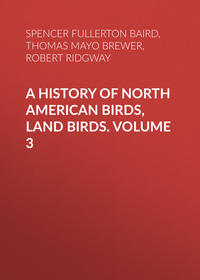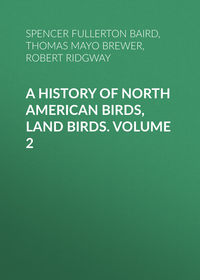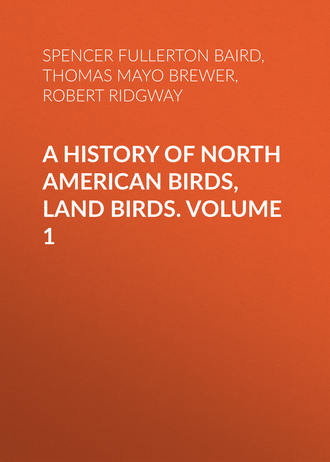 полная версия
полная версияA History of North American Birds, Land Birds. Volume 1
The eggs measure .70 by .55 of an inch, have a pinkish-white ground, blotched with purple and brown of various shades and tints. They are disposed chiefly about the larger end, usually in a ring. The eggs are oval in shape and slightly pointed at one end.
Perissoglossa carbonata, BairdCARBONATED WARBLERSylvia carbonata, Aud. Orn. Biog. I, 1831, 308, pl. lx (Kentucky).—Nutt. Helinaia carbonata, Aud. Syn.—Ib. Birds Am. II, 1841, 95, pl. cix. Dendroica carbonata, Baird, Birds N. Am. 1858, 287; Rev. Am. Birds, 207.
Sp. Char. Bill brownish-black above, light blue beneath. Iris hazel. Feet light flesh-color. Upper part of the head black. Forepart of the back, lesser wing-coverts, and sides dusky, spotted with black. Lower back dull yellowish-green, as is the tail, of which the outer web of the outer feather is whitish. Tip of the second row of coverts white, of the first row yellow; quills dusky, their outer webs tinged with yellow. A line from the lore over the eye; sides of the neck and the throat bright yellow. A dusky line behind the eye. The rest of the under parts dull yellow, excepting the sides. Length, 4.75 inches; bill above, 4.42; tarsus, .75. (Audubon).
Hab. Kentucky.
This species continues to be known only by the description and figure of Audubon.
Judging from the description, this species is closely related to P. tigrina, but seems to be distinct in the pure black of the top of the head, the absence of orange-brown on the cheeks, the white of the wing being on the middle coverts instead of the greater, and the tail-feathers being yellowish-green; the outer web of outer feather white, instead of a large spot on the inner web, etc. The back appears more distinctly streaked.
Habits. Two specimens of this Warbler, obtained near Henderson, Ky., May, 1811, by Mr. Audubon, are all its claim to be recognized as a good species. None have since been seen. These birds are described as having been busily engaged in collecting insects among the branches of a dogwood tree. Their motions were like those of other Warblers. This is all we as yet know as to the history of this species, and its claims to be regarded as a good and distinct species are involved in doubt.
Genus DENDROICA, GraySylvicola, Gray, Genera Birds, 2d ed. 1841, 32. (Not of Humphreys nor Swainson.)
Dendroica, Gray, Genera Birds, Appendix, 1842, 8.
Rhimamphus, Hartlaub, Rev. Zool. 1845, 342. (Not of Rafinesque, Am. Monthly Mag. 1818, and Jour. de Phys. 1819.)
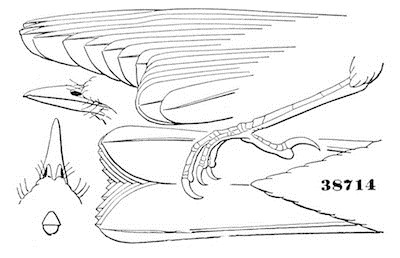
Dendroica coronata.
38714
Gen. Char. Bill conical, attenuated, depressed at the base, where it is, however, scarcely broader than high, compressed from the middle. Culmen straight for the basal half, then rather rapidly curving, the lower edge of upper mandible also concave. Gonys slightly convex and ascending. A distinct notch near the end of the bill. Bristles, though short, generally quite distinct at the base of the bill. Tarsi long; decidedly longer than middle toe, which is longer than the hinder one; the claws rather small and much curved; the hind claw nearly as long as its digit. The wings long and pointed; the second quill usually a very little longer than the first. The tail slightly rounded and emarginate.
Colors. Tail always with a white or yellow spot; its ground-color never clear olive-green. In D. æstiva edged internally with yellow.
Eggs usually with a white or a bluish-white ground, marked with purplish-brown and obscure lilac; in some, mingled with varying shades of sienna-brown. Nest, so far as known, in bushes and trees, except D. palmarum, which is on the ground.
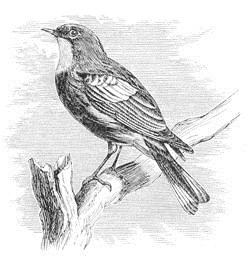
Dendroica auduboni.
The genus Dendroica is one of the most extensive as to species of any in North America, and scarcely admits of any subdivision. There is a little variation in the bill, wings, etc., the chief peculiarities being in D. castanea and pennsylvanica, in which the bill is broader, and more depressed, with longer bristles; in D. striata, where the bill is narrow with scarcely any bristles; and in D. palmarum and kirtlandi, where the wings are very short, scarcely longer than the tail. D. palmarum has the tarsus unusually long. The colors in all are strongly marked, and the species are among the most beautiful of all belonging to our fauna, and are the most conspicuous for their numbers and in their migrations.
The difference in manners between certain members of this genus is remarkable; thus, the D. palmarum is very terrestrial in its habits, walking upon the ground with the ease and grace of a Titlark (Anthus), and, like these birds, it has a wagging motion of the tail. On the other hand, the Dendroica dominica is as much a Creeper as is the Mniotilta varia; creeping not only along the branches, but the cornices and lattices of buildings, with the facility of a Nuthatch (Sitta). Both these species, however, may often be seen hopping among the foliage of the trees, now and then snapping an insect on the wing, in the manner of others of the family.
Species and VarietiesInner webs of tail-feathers with a large patch, or broad edge, of yellow Group A.
Inner webs of tail-feathers with a large patch, or broad edge, of white.
Wings with conspicuous white markings Group B.
Wings without conspicuous white markings37 Group C.
Group A.—Golden WarblersRump and crissum without rufous markings Series I.
Rump and crissum with rufous markings Series II.
Series IPrevailing color rich yellow, shaded on upper parts with olive-green. ♂ with streaks of chestnut across the breast and along the sides, and with or without a greater or less tinge of the same on the crown. ♀ with the streaks beneath obsolete or entirely wanting; no rufous on crown. Juv. paler and duller than the ♀, sometimes quite ashy.
A. Tarsus less than .65 of an inch. Outer webs of tail-feathers with yellow predominating.
1. D. æstiva. Crown generally pure yellow, sometimes with only a tinge of rufous; lower webs of wing-coverts and tertials pure yellow; rump and upper tail-coverts much mixed with the same. Wing-formula,38 1 = 2, 3; wing, 2.60; tail, 2.05; bill, from nostril, .30; tarsus, .62. Hab. Entire continent of North America; in winter south to Bogota and Cayenne; Trinidad (only locality in West Indies).
B. Tarsus not less than .70 of an inch. Outer webs of tail-feathers with dusky predominating.
a. Crown without any rufous, or with only a tinge.
2. D. petechia. Nape olive-green (except in juv.); sides streaked (except in juv.). Crown greenish, sometimes tinged with orange-rufous anteriorly; lower webs of wing-coverts, etc., not pure yellow, and rump and upper tail-coverts without any admixture of yellow. Hab. West Indies (except Barbadoes and Trinidad); not on the Continent.
Lower part of throat streaked; outer webs of wing-coverts hardly appreciably different from the general surface. Above golden yellowish-olive; crown generally without a trace of rufous. Wing-formula, 2 = 3, 4, 1, 5; wing, 2.55; tail, 2.10; bill, .30; tarsus, .80. Hab. Cuba and the Bahamas … var. gundlachi.39
Lower part of throat not streaked; outer webs of wing-coverts decidedly yellowish, and quite different from the general surface. Above greenish yellow-olive; crown almost always strongly tinged with rufous. Wing-formula, 4, 3, 2, 5, 1, 6; wing, 2.70; tail, 2.25; bill, .35; tarsus, .79. Hab. Jamaica and Hayti? … var. petechia.40
Whole throat sometimes streaked; back also sometimes with streaks of dark castaneous; green above lighter than in var. petechia, the rump sometimes tinged with yellow. Wing-formula, 2, 3, and 4 equal, 5 = 1; wing, 2.50; tail, 2.00; bill, .34; tarsus, .78. Hab. Porto Rico, St. Thomas, St. Croix, and St. Bartholomew. … var. ruficapilla.41
3. D. aureola.42 Nape always ashy; sides never streaked. Abdomen, anal region, and axillars nearly white; forehead and crown strongly tinged with rufous; nape dark ashy. Wing-formula, 2, 3, and 4 equal, 5, 1 = 6; wing, 2.55; tail, 2.00; bill, .32; tarsus, .75. Hab. Galapagos Islands.
b. Crown with only a sharply defined ovate patch of dark purplish-rufous.
4. D. capitalis.43 A broad superciliary stripe of pure yellow; wing-formula, 3 = 4, 2, 1 = 5; wing, 2.30; tail, 2.00; bill, .30; tarsus, .70. (♀ distinguishable from that of the varieties of petechia by the distinctly yellow upper eyelid, and considerably shorter tarsus.) Hab. Barbadoes Island, West Indies.
c. Head all round rufous.
5. D. vieilloti. (♀ not distinguishable from that of other species.) Hab. Continental Middle America.
Breast and sides with broad streaks of rufous; outer webs of wing-coverts and tertials pure yellowRufous of the throat with the posterior outline sharply defined against yellow of jugulum. Wing-formula, 3, 4, 2, 1, 5; wing, 2.75; tail, 2.10; bill, .34; tarsus, .75. Hab. New Granada (Carthagena, etc.) … var. vieilloti.44
Rufous of the throat covering the jugulum and blending with the streaks of the breast. Wing-formula, 3, 2, 4, 1, 5; wing, 2.45; tail, 2.05; bill, .27; tarsus, .64. Hab. Isthmus of Panama. … var. rufigula.45
Breast and sides with only very narrow or scarcely appreciable streaks of rufous; outer webs of wing-coverts, etc., scarcely different from general surface.
Rufous of the head confined to it, and abruptly defined all round. Wing-formula, 3, 2 = 4, 1, 5; wing, 2.70; tail, 2.25; bill, .31; tarsus, .72. Hab. Mexico (from Honduras and Yucatan to Mazatlan) … var. bryanti.46
Series II.
Prevailing color yellow; crown, rump, and crissum with spots of rufous; a band of the same on the side of the head, from bill (meeting both on forehead and on chin) around eye and over ear-coverts.
6. D. eoa.47 Hab. Jamaica (Gosse).
Group BBase of primaries with white patch.
Two white bands on wing Series I.
No white bands on wing Series II.
Base of primaries without white patch.
Rump yellow.
Crown with a yellow spot Series III.
Crown without a yellow spot Series IV.
Rump not yellow.
Throat white (with black streaks in striata and pharetra) Series V.
Throat yellow or orange Series VI.
Throat black, or mixed with black Series VII.
Series I7. D. olivacea. ♂. Head and neck, all round, fine light orange-rufous; a broad black “spectacle” along side of the head. ♀. Head yellowish, dusky on top; spectacle obsolete. Hab. Whole of Eastern Mexico; Guatemala.
Series II8. D. cærulescens. ♂. Head dark blue above and black underneath; a black patch covering whole lateral and under side of head and lateral lower parts. Rest of upper parts dark blue; bases of primaries and abdomen pure white. ♀. Above olive, with a light superciliary stripe; beneath wholly light greenish-buff; base of primaries white. Hab. Eastern Province of United States; in winter south into Cuba, Jamaica, and St. Domingo.
Series III9. D. coronata. A yellow patch on each side of the breast; above ashy streaked with black; belly white. ♂. Breast more or less black; upper parts ash with a bluish tinge. ♀. Breast only streaked with black; ash of upper part grayish or brownish.
Throat white; a white superciliary streak; two white bands on wing. Hab. Eastern Province of North America, north to Alaska and Greenland; in winter south to Panama and West Indies (resident in Jamaica!) … var. coronata.
Throat yellow; no white superciliary streak; one white patch formed by the fusion of the two bands on the wing. Hab. Western Province of North America from British Columbia, south to Cape St. Lucas and Jalisco, Western Mexico; east to Rocky Mountains. … var. auduboni.
Series IV10. D. maculosa. Whole lower parts bright yellow; black streaks across breast and along sides; crown ash; lores, auriculars, and back black. ♀ scarcely different. Hab. Eastern Province of North America, from Fort Simpson to Panama; Cuba and Bahamas.
Series VA. Above ashy-blue, or soft bluish-green.
11. D. cærulea. Lower parts pure white or greenish-white; with or without a narrow band across the breast; above fine ashy-blue, or soft bluish-green; if blue (♂), the back and crown streaked with black; if green (♀ and juv., these streaks obsolete. Hab. Eastern Province of United States (rare northward except in Mississippi Valley), south to Bogota in winter; Cuba.
B. Above not ashy-blue nor bluish-green, but streaked with black upon an ashy greenish-olive or yellowish ground, or else bright olive-green.
a. Sides more or less rufous, and without black or dusky streaks on under surfaces.
12. D. pennsylvanica. ♂. Crown pure yellow; throat and auriculars pure white; ♀ ad. similar, but crown greenish, and more or less streaked. Juv. Above bright olive-green, nearly grass-green, without streaks except on the back; side of head, and sides, clear ashy, the latter with or without a trace of chestnut; eyelids and medial lower parts pure white. Hab. Eastern Province of United States, south to Panama; Bahamas.
13. D. castanea. ♂. Crown reddish-chestnut; throat and sides rufous; auriculars black. ♀ similar, but crown thickly streaked, sometimes without a trace of rufous; jugulum and throat only tinged with rufous. Juv. Above greenish-olive, streaks obsolete; beneath, including lower tail-coverts, pale greenish-buff, or whitish-buff, and without any trace of streaks on the sides (distinction from ♀ of D. striata) the sides usually with a tinge of chestnut. Hab. Eastern Province of North America, from Hudson’s Bay Territory to New Granada.
b. Sides without any rufous, and with black or dusky streaks.
Medial lower parts not streaked; inner webs of tail-feathers with broad patch of white14. D. striata. ♂. Crown deep black; auriculars and lower parts white; throat with two series of black streaks, converging and forming an angle on the chin. Above ashy streaked with black. ♀ similar, but crown greenish streaked with black; lower parts tinged with greenish. Juv. Above greenish-olive, the streaks obsolete; beneath pale greenish-yellow; the lower tail-coverts pure white. Hab. Eastern Province of North America, north to Greenland and Kodiak, south to Bogota, Cuba, and Bahamas.
Medial lower parts streaked with black; inner webs of tail-feathers merely edged with white15. D. pharetra.48 ♂. Above grayish-white, with broad streaks of black; posteriorly, plain brownish-gray; lower parts with cuneate spots of black. Hab. Jamaica.
Series VIA. A black “mask” around the eye and on auriculars, and extending down the side of the throat; a light superciliary stripe continued back into a large space, of similar color, on side of neck.
16. D. blackburniæ. Crown with an orange or yellowish spot (exposed or concealed); superciliary stripe, side of neck and throat, intense orange-red (♂ ad.), or varying from this to pale buff (juv.). ♀ intense black above; back streaked with white or yellowish. ♀ olive-gray above, streaked with black. Juv. olive-gray above without distinct streaks. Hab. Eastern Province of United States, south to Ecuador; Bahamas.
17. D. dominica. Crown without an orange or yellowish spot; superciliary stripe and side of neck pure white; throat gamboge-yellow; above ash, without streaks.
Superciliary stripe bright yellow anterior to the eye. Bill, .45; tarsus, .60; wing, 2.60; tail, 2.00. Hab. Atlantic United States and West Indies … var. dominica.
Superciliary stripe pure white anterior to the eye. Bill, .35; tarsus, .60; wing, 2.70; tail, 2.20. Hab. Mississippi region of United States; Mexico (Yucatan on east coast, and Colima on west coast); Guatemala and Honduras … var. albilora.
B. No black “mask.” Superciliary stripe scarcely reaching behind the eye. Sides of neck ashy like the back.
18. D. graciæ. Auriculars, neck, crown, and upper parts generally, ashy; a supra-loral stripe, a crescent on the lower eyelid, and the anterior lower parts gamboge-yellow. Crissum white.
Back and sides streaked with black; abdomen whiteYellow of throat terminating abruptly at the jugulum; supra-loral stripe extending about .20 of an inch past the eye, this portion of it white; dorsal streaks broad. Wing, 2.60; tail, 2.20. Hab. Arizona (Fort Whipple) … var. graciæ.
Yellow of throat covering whole jugulum, and not ending abruptly; supra-loral stripe scarcely passing the eye, and wholly yellow; dorsal streaks narrow. Wing, 2.20; tail, 1.95. Hab. British Honduras (Belize) … var. decora.
Back and sides not streaked with black; abdomen yellowYellow of throat extending back to the crissum; supra-loral stripe as in the last; dorsal streaks wanting. Wing, 2.10; tail, 1.95. Hab. Porto Rico … var. adelaidæ.49
Series VIIThroat black in ♂, mixed with black in ♀.
A. Sides streaked; black of throat with its posterior outline concave.
a. Side of head white and black.
19. D. nigrescens. A small yellow spot over the lore; above ash; beneath white. ♂. Whole crown, uniform glossy black; back streaked with black. ♀. Crown ash streaked with black; throat mixed with white anteriorly. Juv. Crown and cheeks ashy; throat mostly white; back without streaks. Hab. Western and Middle Province of United States, south, in winter, into Western Mexico (Oaxaca).
b. Side of head yellow and black, or yellow and olive.
Black of throat covering jugulum; a hidden yellow spot in middle of forehead20. D. chrysopareia. Black above, pure white below; no tinge of yellow behind the black jugular patch. Hab. Eastern Middle America, from Guatemala to Texas (San Antonio).
21. D. virens. Olive-green above, the crown and back without streaks; beneath white, the breast and anal region tinged with black. Hab. Eastern Province of North America, from Greenland to Panama; Cuba; Oaxaca; Heligoland, Europe!
Black of throat confined anteriorly to the jugulum; no yellow spot on forehead22. D. townsendi. Above olive-green, the crown and back with conspicuous black streaks; beneath yellow anteriorly, and white posteriorly. ♀, black of throat mixed with yellow; juv., no black on throat, and streaks on back obsolete. Hab. North and Middle Province of United States, south, in winter, into Guatemala.
B. Sides not streaked; black of throat with its posterior outline convex.
23. D. occidentalis. Above ash tinged with olive; beneath white. Head nearly all yellow. ♂. Top of head yellow with a few small black spots; nape black; back streaked with black; sides pure white. (♀ not seen.) Juv. Yellow of crown overlaid by olive; above greenish-plumbeous, without any black on nape or back; throat yellowish-whitish; sides tinged with ashy. Hab. Western and Middle Province of United States, south to Guatemala.
Group CA. Above ash; no supra-loral stripe; eyelids not yellow.
24. D. kirtlandi. Above, including side of head and neck, bluish-ash; crown and back streaked with black; beneath (except crissum) pale yellow; breast speckled, and sides streaked with black; lores and orbital region, black; eyelids white. Hab. Eastern Province of United States (Cleveland, Ohio), and Bahamas.
25. D. pityophila.50 Above, including side of head and neck, dull ash; the forehead and crown olive-green; crown and back not streaked; beneath white; the throat and jugulum yellow; sides ashy; no specks on breast, nor streaks on sides, but a few along side of neck, between the ash and yellow. Hab. Cuba.
B. Olive-green or brown above; a supra-loral stripe of yellow; eyelids yellow.
a. Above olive-green, without streaks; crissum white; sides of breast with obsolete grayish streaks.
26. D. pinus. Forehead and ear-coverts olive; abdomen white; yellow supra-loral stripe not continued behind the eye. ♀ more grayish; juv. above umber, beneath light grayish-brown, tinged with yellow. Hab. Eastern Province of United States; Bahamas.
? 27. D. montana. Forehead and ear-coverts yellow; abdomen yellow; yellow supra-loral stripe continued past the eye into the yellow of the auriculars. (♀ and other stages unknown.) Hab. “Blue Mountains of Virginia.”
b. Above olive-green, the back streaked with chestnut; crissum yellow; streaks of black on sides.
28. D. discolor. Bright gamboge-yellow beneath; streak on lores and along side of neck, as well as along sides and flanks, deep black; dorsal feathers chestnut medially. ♀ duller, but similar; juv. not seen. Hab. Eastern Province of United States: in winter, throughout West Indies.
c. Above olive-brown, the back not streaked; crissum gamboge-yellow; streaks of reddish-chestnut on sides.
29. D. palmarum. Ad. Forehead and crown deep rufous; superciliary stripe bright yellow, continued back over auriculars; sexes alike. Juv. and ad. in winter. Crown brownish, streaked with dusky; streaks on sides more dusky. Hab. Eastern Province of North America, north to Fort Simpson and Hudson’s Bay; Bahamas; Cuba, St. Domingo, and Jamaica, in winter.
Dendroica æstiva, BairdYELLOW WARBLER; SUMMER YELLOW-BIRDMotacilla æstiva, Gm. Syst. Nat. I, 1788, 996.—Sylvia æstiva, Lath.; Vieill. II, pl. xcv.—Aud. Orn. Biog. I, pl. xxxv. 93. Sylvicola æst. Swains.—Aud. Birds. Am. II, pl. lxxxviii. Rhimamphus æst. Bon.; Cab. Jour. III, 472 (Cuba). Dendroica æst. Baird, Birds N. Am. 1858, 282; Rev. 195.—Sclater, Catal. 1861, 32, No. 194.(Ecuador, Cayenne, N. Granada).—Taylor, Ibis, 1864, 81 (Trinidad).—Cooper & Suckley, P. R. R. XII, II, 1859, 181 (N. W. coast).—Samuels, 237.—Dall & Bannister, (Alaska).—Cooper, Orn. Cal. 1, 1870, 87. Sylvia carolinensis, Lath. Ind. Orn. II, 1790, 551. ? Sylvia flava, Vieillot, II, 1807, 31, pl. lxxxi. Sylvia citrinella, Wils. II, pl. xv, fig. 5. Sylvia childreni, Aud. Orn. Biog. I, 1831, pl. xxxv (young). ? Sylvia rathbonia, Aud. Orn. Biog. I, 1831, pl. lxv. Sylvicola r. Aud. Birds Am. II, pl. lxxxix. Motacilla rubiginosa, Pallas, Zoög. Rosso-Asiat. I, 1831, 496 (Kodiak). Rhimamphus chryseolus, Bon. Bull. Soc. Linn. Caen, II, 1851, 32 (D. æstiva, from South America; Cayenne).
Other localities: Xalapa, Sclater, P. Z. S. 1859, 363. Guatemala, Sclater & Salvin, Ibis, 1859, page 11. Panama, winter, Lawr. Ann. N. Y. Lyc. 1861, 322. Turbo, N. Granada, Cass. Pr. A. N. Sc. 1860, 191. Bogota, Sclater, Pr. 1855, 143. City of Mexico, Ib. 1864, 172.
Sp. Char. Bill lead-color. Head all round, and under parts generally, bright yellow; rest of upper parts yellow-olivaceous, brightest on the rump. Back with obsolete streaks of dusky reddish-brown. Fore breast and sides of the body streaked with brownish-red. Tail-feathers bright yellow; the outer webs and tips, with the whole upper surfaces of the innermost one, brown; extreme outer edges of wing and tail-feathers olivaceous like the back; the middle and greater coverts and tertials edged with yellow, forming two bands on the wings. Female similar, with the crown olivaceous like the back, and the streaks wanting on the back, and much restricted on the under parts. Tail with more brown. Length of male, 5.25; wing, 2.66; tail. 2.25. (No. 940.) Young. Dull brownish-olive above; pale ochraceous-yellow beneath, with the throat more whitish; the yellow of tail restricted to inner half of inner webs. The latter feature will serve to distinguish it from any other North American species.




